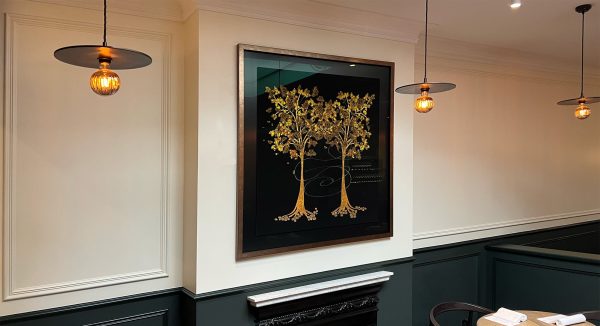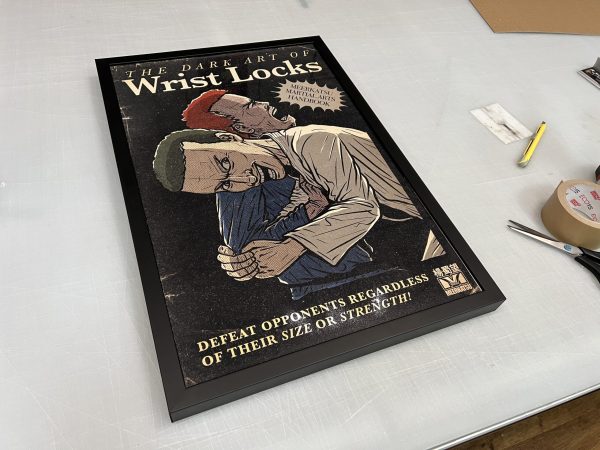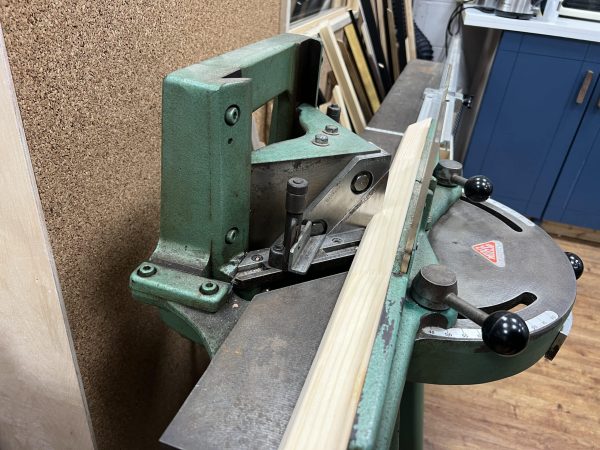Framing Giclee Prints
Framing Fine Art Prints: A Must
Whether you call yourself an artist, illustrator, photographer, art collector, or art enthusiast, if you find yourself with a fine art print in your hands, you’ll want to frame it.
Framing your Giclee prints has a wealth of benefits. Read on to find out!

Frames Protect Your Prints from Damage
One of the greatest benefits of having a frame is that it adds a layer of protection to your print. With your print displayed or stored safely in a frame, you don’t have to worry about natural or manmade problems like dust, dirt, tears, folds, or stains. In addition to this kind of physical damage from humans, the everyday forces of humidity, oxygen, and light all work together to affect the print in a number of negative ways.
One of the most tragic things a high-quality fine art print can experience is warping. If you’ve ever hung children’s drawings up somewhere with excessive amounts of humidity, like the bathroom or kitchen, you know that once paper warps, flattening it isn’t an easy project. Framing will help keep the art flat so it stays flat.
Airbourne Pollution
In addition to protection from humidity, preventing the light and air from reaching your prints is best practice when it comes to keeping fine art prints. The days of nicotine smoke staining wallpaper are thankfully mostly gone, but any airborne pollutant from a wood burner for example, or aerosols like ‘Dry Shampoo’ can cause damage.
Dose Light Damage Art
The reason we don’t want air or light touching the paper is this: oxygen and sunlight trigger the production of acid in paper. Acid is an archival paper’s worst nemesis—it causes yellowing and discolouration. ALSO the UV rays in sunlight can bleach the colours of an artwork over time.
But glass lets light through! other wise we couldnt see the art work…
Lucky there there are special glasses such as Art Glass and Tru Veiw that are sold with UV protection ratings. Starting at 70% all the way up to 99%. These glazing options come at a price, but if you invested in art you will want its value to go up not DOWN.
If you want to extend the life of a print talk to your bespoke picture framer.
Framed Prints Are Elevated
Let’s be honest. Frames are classy. If you’re settled into your home, you don’t want it to look like student bedroom. No matter how nice a print is, mounting it directly on the wall takes it dangerously close to that territory.
The good thing is that this rule works both ways. Any poster or print inside a frame immediately feels elevated. Especially if you use a moulding that suits your home decor.

Framing Prints: Getting it All Together
When framing a print, obviously there are two essential components: the frame and the print. But there’s more to it than just those two elements. At least, there are when you’re dealing with fine art prints.
But we have to start somewhere. Here’s a quick overview of the best possible ways to acquire your frames and your prints (and how to make sure they’re compatible).

Buying Frames Off the Shelf
Getting over-the-counter frames is a lot like buying OTC medications. Sometimes, it’s exactly what you need. Other times, you have to talk to an expert.
If you feel completely lost when it comes to frames, browsing frames on the shelf of a local craft store or frame shop is a great way to get an idea of what your framing style is.
Another benefit to over-the-counter frames is that they’re cheaper. The downside is that they only come in set sizes. If you’re on a tight budget, the best way to frame prints is to purchase the frame before you print your image. This way you can go to a custom print shop to meet your frame’s needs perfectly.
Getting Custom-Sized Frames
If you’ve already printed your image or you’ve bought one online, you might be in a situation where you need (or want) a custom-sized frame. Your best bet is to visit your local professional at a nearby framing shop. With their advice, your print will look great, last long, and add beauty wherever it belongs.
If you don’t want the visit a local frame shop, you can also order them online from the convenience of your home.

Printing Custom-Sized Art
No matter what position you’re in—with or without a standard or custom frame—you should consider getting custom-sized prints. The benefit to this is that you’ll have a unique custom print unlike any other.
When you visit a custom print shop, like Exhibit Printing, an expert will be able to give you feedback based on your individual needs. If you’re focused on getting archival, giclée prints, you need to ensure that the fine art paper is acid-free before the ink is applied.
When in Doubt, Go Get a Mount!
Remember when I said framing involved more than just a frame? Picture mounts are an important component to giclée prints because cut picture mounts prevent prints from touching the glass. They also add a touch of style to make the print feel even more classy.
You can mount your prints yourself but going to a professional will ensure that your print turns out truly giclée. Here’s what you need to know about mounting prints.
High-Quality Mount Materials
Artists usually don’t skimp on the acid-free paper, but sometimes it slips their minds that acid-free paper mounts and backboards are just as important. This process, also known as matting, provides another line of defence to ensure your prints last a lifetime
Know Before You Go
Before you purchase your frames, print your artwork, and cut mounting boards, you should plan everything out. Like a puzzle, there are a lot of parts that need to fit together just right when you frame a print.
You’ll need to know the picture size and the frame size, but that’s not all. You need to know what mat border and window size you want, as well as the mat colour. All these parts work together to create the perfect display for your fine art.
If you have your frame, but you still need your mount and/or print, you can simply take everything you have to a print shop, and the professionals there will take care of everything. If you have no idea where to start, pop into your local print shop and ask some questions! The experts are there to help, and they’ll have a lovely time chatting with you.
Custom Picture Mounts
Another great benefit of walking into (or calling!) your print shop is that they can help you cut picture mounts that are perfect for your print and your needs.
Any frame—new or reused—will fit your image beautifully with a custom cut picture mount. You can adjust the window mount and border size, and they come in a wide range of colours.
If you know where you want to hang your print, a coloured mount can tie everything together, creating a look of cohesiveness with intentional design. If you’re not quite sure where you’ll put it, or if you’ll be giving it away to a friend (or selling it to a client!), a coloured mount is a bit risky.
If you choose a colour that doesn’t match well, you risk downgrading the print instead of elevating it. If you’re not sure, go for white. White mats or mounting boards are always a great choice. They’re clean and match with any style—refined, elegant, modern, minimalistic. A white custom picture mount is a great option for any artist or art collector.
How to Mount an Archival Giclée Print
After you’ve chosen all your materials (in all the proper sizes and colours!), you’re ready to mount! There are some dos and don’ts to mounting prints if you want to preserve quality and ensure that they’ll last a lifetime.
If you want to call your art giclée, you cannot use mounting tape. No printer in their right mind would recommend mounting tape for an archival print. It can damage prints—making them harder to remount in the future and decreasing their value and quality.
Dry mounting is okay for prints in general, but you should never mount an archival print.
Your best mounting option for giclée prints is to use photo corners. These are essentially little pockets that adhere to the mounting board and not to your print. The corners of your print will fit nicely into the pockets, preserving all the qualities that make your print archival.
Glass Versus Plexiglass: Which is Better?
The age-old debate of plexiglass versus glass still rages on. Ultimately, the right decision is a personal choice. No one size fits all for any single person, print, or situation. And there are a variety of options in both categories.
Plexiglass (Also Known as Acrylic)
Plexiglass ships better. First, it’s a lighter-weight material than glass, and it’s not fragile like glass. If it does happen to break, there little to no risk that it will damage the print. Plexiglass is also generally less reflective than glass, and all these pros can make plexiglass seem like the obvious choice.
But plexiglass has its downsides, too. It scratches easily, attracts dust, and is generally more expensive. If you’re framing giclée prints, you also have to watch out for acrylic materials that aren’t archival.
Glass
Glass is a good option if you’re on a budget. It’s usually less expensive, but the costs of fancier treated glasses will run higher.
You can get a variety of different kinds of glass. Some are simply nonreflective. Others are conservation/museum quality which means they reflect less light and they filter UV light to protect prints. These are ideal if you have an archival print that you want to preserve.
It doesn’t scratch easily, but when it breaks, it shatters. It’s heavy, fragile, and risks damage to your prints if it breaks.
With pros and cons to each, there’s no right or wrong choice. If you want an expert’s opinion, talk to your local print professional for advice on framing your prints.
